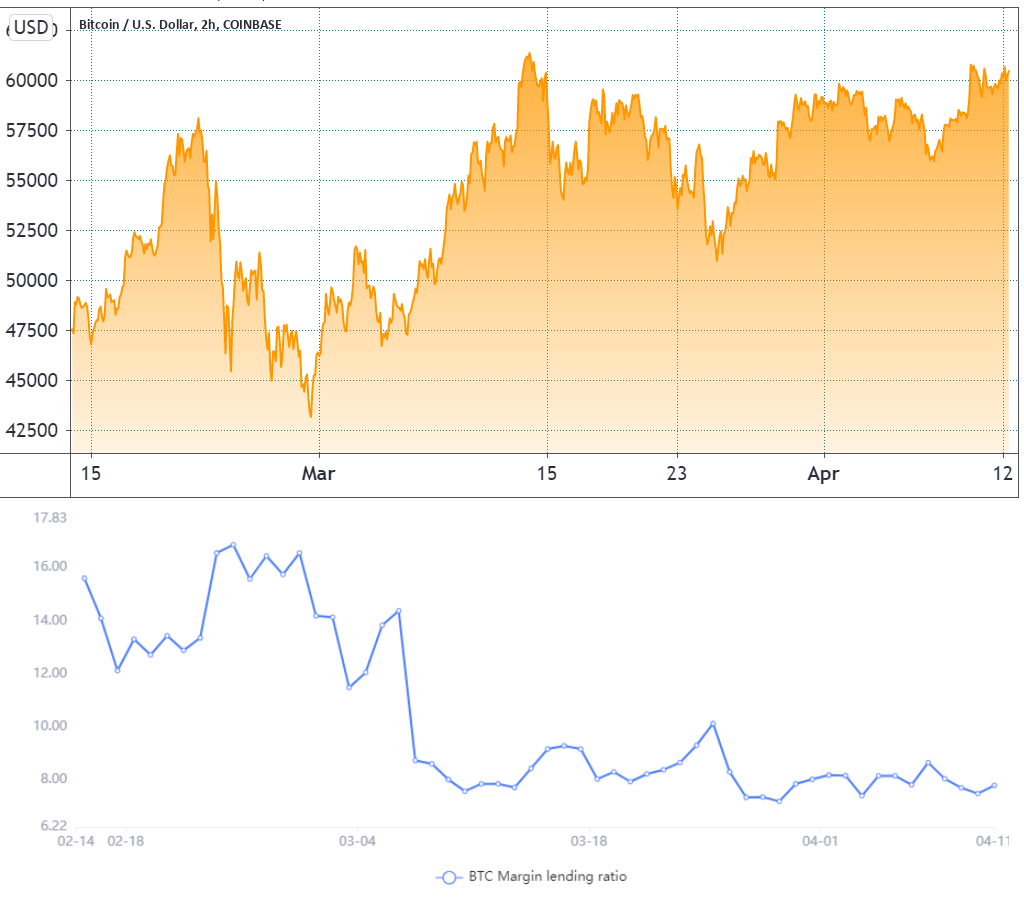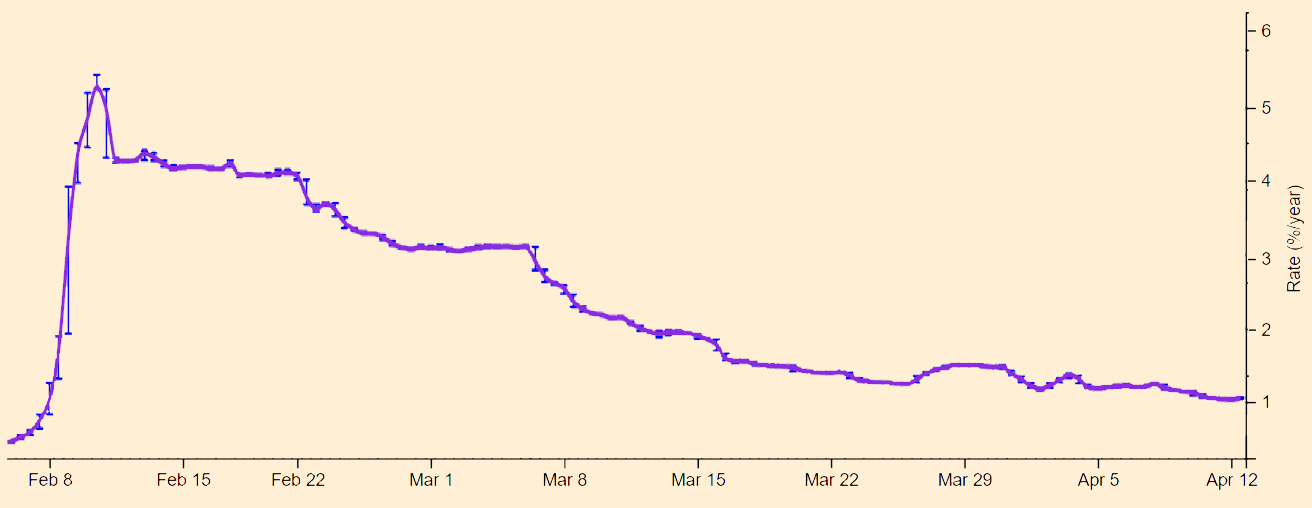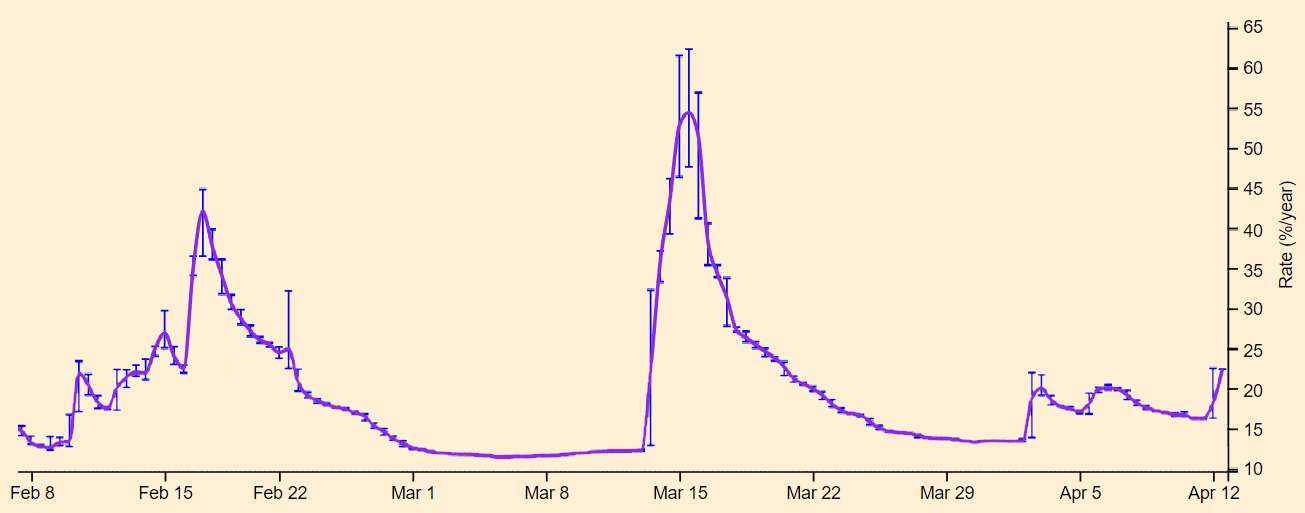Margin trading allows an investor to borrow money or cryptocurrency to leverage their trading position and increase its size or the expected return. For example, borrowing Tether (USDT) will allow one to buy Bitcoin (BTC), thus increasing the exposure. Although there’s an interest rate involved with borrowing, the trader expects BTC’s price appreciation to compensate for it.
Newer traders might be unaware of this, but investors can borrow BTC to margin trade a short position, thus betting on price downside. This is why some analysts monitor the total lending amounts of Bitcoin and Tether to gain insight into whether investors are leaning bullish or bearish.
Interestingly, data shows that even as Bitcoin’s price aims for a new all-time high, the BTC/USDT borrow ratio on OKEx has reached its lowest level since Nov. 20, 2020. While this figure still favors bulls, it raises questions about what catalysts are behind the move.
 Bitcoin price in USD (above) and USDT/BTC lending ratio (below). Source: TradingView, OKEx
Bitcoin price in USD (above) and USDT/BTC lending ratio (below). Source: TradingView, OKEx
Whenever traders borrow USDT or other stablecoins, they are likely using it to long cryptocurrencies. On the other hand, BTC borrowing is mainly used for short positions.
This means that theoretically, whenever the USDT/BTC lending ratio goes up, the market is angled in a bullish manner. The opposite movement indicates more demand for Bitcoin shorts.
As shown in the chart above, USDT loans on OKEx have been holding at roughly eight times larger than Bitcoin-denominated loans. Albeit on the bullish side, this is near the lowest level since Nov. 17, 2020.
Borrowing rates for the bears have never been this low
Unlike perpetual futures (inverse swaps), margin trades take place in regular spot markets. To start margin trading, a trader only needs to transfer collateral funds to a margin account. Most exchanges offer 3x to 10x leverage, depending on the asset’s volatility and market conditions.
This indicator has halved since late February, despite BTC marking a new $61,800 all-time high and sustaining daily candle closes above $55,000 for the past 17 days. Nevertheless, a hike in the Bitcoin borrowing rate would undoubtedly cause BTC shorts to reduce their leverage.
 Bitfinex BTC short-term lending rate. Source: BFX Rates
Bitfinex BTC short-term lending rate. Source: BFX Rates
According to data from Bitfinex, BTC’s short-term lending has rate plummeted to 1% per year. Therefore, high costs are definitely not behind the much smaller BTC borrowing activity. Although OKEx does not provide a chart, both the Poloniex and Quoine exchanges displayed a similar trend, according to data from Coinlend.
Bulls kept their long positions despite the fee increase
Traders betting on a negative price swing must borrow BTC to margin trade a short position. Even in this situation, they will still need to pay interest and trade it to U.S. dollars or stablecoin. To close the transaction, the buyer must repurchase the BTC while hoping for a lower price and return it to the lender with the additional interest.
 Bitfinex USD short-term lending rate. Source: BFX Rates
Bitfinex USD short-term lending rate. Source: BFX Rates
This time around, there has been a massive spike in the USD lending rate in mid-March as Bitcoin surpassed $60,000. The leveraged long frenzy quickly reverted as BTC dropped 13% over the following days, and this caused fiat and stablecoin borrowing rates to normalize.
Traders looking to borrow USD or stablecoins to buy Bitcoin have been paying from 15% to 23% per year over the last couple of weeks. This rate is likely why the OKEx USDT and BTC borrow ratio fails to increase despite Bitcoin’s price strength.
Right now, the lending ratio favors bulls
A meager 1% annualized fee was not enough to entice borrowers to short Bitcoin, which is a positive indicator. Had there been any demand for it, the borrowing rate would have gone up.
Consequently, traders should not perceive that the OKEx margin lending ratio being at its lowest level in five months as a bearish signal.
Even though a 23% margin rate for longs is considerably expensive, there is room for further leverage. Hence, $60,000 becoming a support level for Bitcoin should come as no surprise.
The views and opinions expressed here are solely those of the author and do not necessarily reflect the views of Cointelegraph. Every investment and trading move involves risk, and you should conduct your own research when making a decision.
Source
